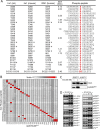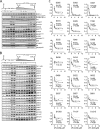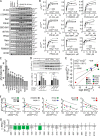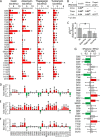Insulin and metabolic stress stimulate multisite serine/threonine phosphorylation of insulin receptor substrate 1 and inhibit tyrosine phosphorylation
- PMID: 24652289
- PMCID: PMC4007441
- DOI: 10.1074/jbc.M114.554162
Insulin and metabolic stress stimulate multisite serine/threonine phosphorylation of insulin receptor substrate 1 and inhibit tyrosine phosphorylation
Abstract
IRS1 and IRS2 are key substrates of the insulin receptor tyrosine kinase. Mass spectrometry reveals more than 50 phosphorylated IRS1 serine and threonine residues (Ser(P)/Thr(P) residues) in IRS1 from insulin-stimulated cells or human tissues. We investigated a subset of IRS1 Ser(P)/Thr(P) residues using a newly developed panel of 25 phospho-specific monoclonal antibodies (αpS/TmAb(Irs1)). CHO cells overexpressing the human insulin receptor and rat IRS1 were stimulated with insulin in the absence or presence of inhibitors of the PI3K → Akt → mechanistic target of rapamycin (mTOR) → S6 kinase or MEK pathways. Nearly all IRS1 Ser(P)/Thr(P) residues were stimulated by insulin and significantly suppressed by PI3K inhibition; fewer were suppressed by Akt or mTOR inhibition, and none were suppressed by MEK inhibition. Insulin-stimulated Irs1 tyrosine phosphorylation (Tyr(P)(Irs1)) was enhanced by inhibition of the PI3K → Akt → mTOR pathway and correlated with decreased Ser(P)-302(Irs1), Ser(P)-307(Irs1), Ser(P)-318(Irs1), Ser(P)-325(Irs1), and Ser(P)-346(Irs1). Metabolic stress modeled by anisomycin, thapsigargin, or tunicamycin increased many of the same Ser(P)/Thr(P) residues as insulin, some of which (Ser(P)-302(Irs1), Ser(P)-307(Irs1), and four others) correlated significantly with impaired insulin-stimulated Tyr(P)(Irs1). Thus, IRS1 Ser(P)/Thr(P) is an integrated response to insulin stimulation and metabolic stress, which associates with reduced Tyr(P)(Irs1) in CHO(IR)/IRS1 cells.
Keywords: CHO Cells; Cell Signaling; IRS1; Insulin Resistance; Insulin Signaling; Metabolic Stress; Monoclonal Antibodies; Phosphotyrosine Signaling; Protein Phosphorylation; Signal Transduction.
Figures








Similar articles
-
Serine 302 Phosphorylation of Mouse Insulin Receptor Substrate 1 (IRS1) Is Dispensable for Normal Insulin Signaling and Feedback Regulation by Hepatic S6 Kinase.J Biol Chem. 2016 Apr 15;291(16):8602-17. doi: 10.1074/jbc.M116.714915. Epub 2016 Feb 4. J Biol Chem. 2016. PMID: 26846849 Free PMC article.
-
Prostaglandin F2alpha represses IGF-I-stimulated IRS1/phosphatidylinositol-3-kinase/AKT signaling in the corpus luteum: role of ERK and P70 ribosomal S6 kinase.Mol Endocrinol. 2010 Mar;24(3):632-43. doi: 10.1210/me.2009-0312. Epub 2010 Feb 16. Mol Endocrinol. 2010. PMID: 20160123 Free PMC article.
-
Resistin promotes cardiac hypertrophy via the AMP-activated protein kinase/mammalian target of rapamycin (AMPK/mTOR) and c-Jun N-terminal kinase/insulin receptor substrate 1 (JNK/IRS1) pathways.J Biol Chem. 2011 May 27;286(21):18465-73. doi: 10.1074/jbc.M110.200022. Epub 2011 Apr 8. J Biol Chem. 2011. PMID: 21478152 Free PMC article.
-
Regulation of insulin sensitivity by serine/threonine phosphorylation of insulin receptor substrate proteins IRS1 and IRS2.Diabetologia. 2012 Oct;55(10):2565-2582. doi: 10.1007/s00125-012-2644-8. Epub 2012 Aug 8. Diabetologia. 2012. PMID: 22869320 Free PMC article. Review.
-
GSK3 and its interactions with the PI3K/AKT/mTOR signalling network.Adv Biol Regul. 2017 Aug;65:5-15. doi: 10.1016/j.jbior.2017.06.003. Epub 2017 Jun 27. Adv Biol Regul. 2017. PMID: 28712664 Review.
Cited by
-
Serine Phosphorylation of IRS1 Correlates with Aβ-Unrelated Memory Deficits and Elevation in Aβ Level Prior to the Onset of Memory Decline in AD.Nutrients. 2019 Aug 17;11(8):1942. doi: 10.3390/nu11081942. Nutrients. 2019. PMID: 31426549 Free PMC article.
-
Mechanisms of Insulin Action and Insulin Resistance.Physiol Rev. 2018 Oct 1;98(4):2133-2223. doi: 10.1152/physrev.00063.2017. Physiol Rev. 2018. PMID: 30067154 Free PMC article. Review.
-
The Interplay between Insulin Resistance, Inflammation, Oxidative Stress, Base Excision Repair and Metabolic Syndrome in Nonalcoholic Fatty Liver Disease.Int J Mol Sci. 2021 Oct 15;22(20):11128. doi: 10.3390/ijms222011128. Int J Mol Sci. 2021. PMID: 34681787 Free PMC article. Review.
-
G protein-coupled receptors (GPCRs) That Signal via Protein Kinase A (PKA) Cross-talk at Insulin Receptor Substrate 1 (IRS1) to Activate the phosphatidylinositol 3-kinase (PI3K)/AKT Pathway.J Biol Chem. 2016 Dec 30;291(53):27160-27169. doi: 10.1074/jbc.M116.763235. Epub 2016 Nov 17. J Biol Chem. 2016. PMID: 27856640 Free PMC article.
-
Metabolic Signalling Peptides and Their Relation to Clinical and Demographic Characteristics in Acute and Recovered Females with Anorexia Nervosa.Nutrients. 2025 Apr 14;17(8):1341. doi: 10.3390/nu17081341. Nutrients. 2025. PMID: 40284205 Free PMC article.
References
-
- Reaven G. (2004) The metabolic syndrome or the insulin resistance syndrome?: different names, different concepts, and different goals. Endocrinol. Metab. Clin. North Am. 33, 283–303 - PubMed
-
- Biddinger S. B., Kahn C. R. (2006) From mice to men: insights into the insulin resistance syndromes. Annu. Rev. Physiol. 68, 123–158 - PubMed
-
- Karlsson H. K., Zierath J. R. (2007) Insulin signaling and glucose transport in insulin resistant human skeletal muscle. Cell Biochem. Biophys. 48, 103–113 - PubMed
Publication types
MeSH terms
Substances
Grants and funding
LinkOut - more resources
Full Text Sources
Other Literature Sources
Medical
Molecular Biology Databases
Miscellaneous

